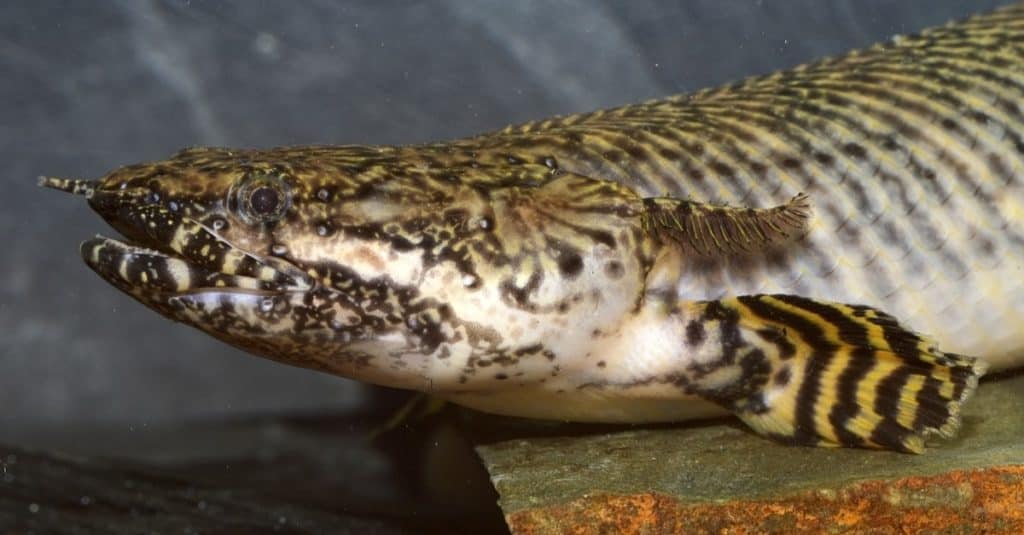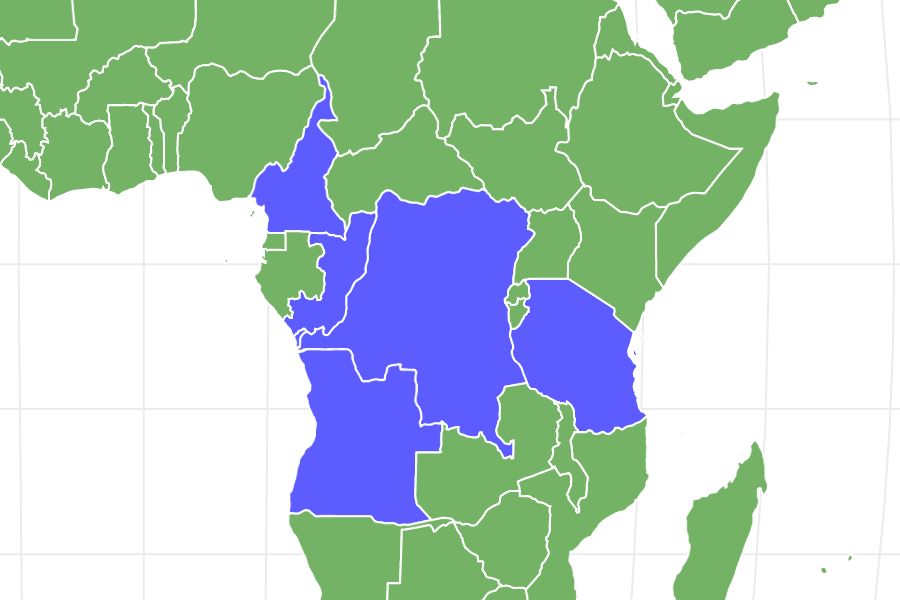Ornate Bichir
Polypterus ornatipinnis
The ornate bichir can survive outside water for short periods of time
Advertisement
Ornate Bichir Scientific Classification
- Kingdom
- Animalia
- Phylum
- Chordata
- Class
- Actinopterygii
- Order
- Polypteriformes
- Family
- Polypteridae
- Genus
- Polypterus
- Scientific Name
- Polypterus ornatipinnis
Read our Complete Guide to Classification of Animals.
Ornate Bichir Conservation Status
Ornate Bichir Facts
- Prey
- insects, smaller fishes and aquatic invertebrates
- Group Behavior
- Solitary
- Fun Fact
- The ornate bichir can survive outside water for short periods of time
- Most Distinctive Feature
- Black and yellow pattern
- Distinctive Feature
- Small dorsal finlets
- Other Name(s)
- Dragonfish, swamp dragon, and dinosaur eel
- Optimum pH Level
- 6.0 – 8.0
- Average Spawn Size
- 100–300
- Habitat
- Streams, rivers, stagnant water, swamps, muddy water, silty water
- Diet
- Carnivore
- Lifestyle
- Nocturnal
- Type
- Ray-finned fish
- Common Name
- Ornate bichir
- Location
- Central and East Africa
Ornate Bichir Physical Characteristics
- Color
- Yellow
- Black
- Skin Type
- Scales
- Lifespan
- 10–15 years
- Length
- 18–24 inches
- Age of Sexual Maturity
- 3 years
- Venomous
- No
- Aggression
- Medium
View all of the Ornate Bichir images!
The ornate bichir can survive outside water for long periods of time.
Summary
Polypterus ornatipinnis, also called ornate bichir, is a species of freshwater fish native to Central and Eastern Africa. More specifically, the fish is found in Lake Tanganyika and the Congo River Basin. This fish is the largest of the “upper jaw bichirs” and is also considered the most attractive fish in the bichir family. The ornate bichir is often kept in a large aquarium tank with a tight lid for recreational purposes.
5 Ornate Bichir Facts
- They’re nocturnal animals hiding or sleeping throughout the day but active at night.
- Ornate bichir is carnivorous fish that feeds on smaller creatures in their surroundings.
- They can grow up to 24 inches and live for 15 years in captivity.
- The ornate bichir has a primitive pair of lungs that allows it to breathe in air.
- This fish can survive for a long time outside water.
Ornate Bichir — Classification and Scientific Name
The scientific name for the ornate bichir is Polypterus ornatipinnis. The historic-looking fish is also called the dragonfish, swamp dragon, and dinosaur eel, all reference to the unique archaic appearance of the fish. The genus name Polypterus is derived from the Greek word “poly” — which means many — and the root word “pteron” (which means fins or wings). It means “many wings,” a reference to the numerous small spiny fins found on the back of this fish.
The ornate bichir belongs to the family Polypteridae along with the reedfish. This group of ray-finned fish is the only family in the order Polypteriformes. There are 12 living species of fish in the Polypteridae family divided into two genera.
Ornate Bichir — Appearance
Ornate bichir is considered the most beautiful fish in the bichir family. Although it looks a lot like an eel, it is actually a species of bony fish with long slender bodies. The body of the ornate bichir is covered in bony scales. The fish also has finlets on its back with anywhere between seven and 18 tips.
Bichirs generally are known for their resemblance to prehistoric fishes. They have black and yellow patterns on the head, body, and fins. The patterning on the fins, which extends prominently to the sides of the fish, is one of its most prominent features.
Ornate bichir can grow to an average length of about 24 inches in captivity, but in the wild, it grows as long as 38 inches. It is the largest of the bichir fishes, characterized by a large upper jaw. The ornate bichir’s eyes are located on the side of its head. The species come in varying colors ranging from brownish-gray to dark brown.
The primitive pair of lungs of this fish allows it to breathe in air directly from the water’s surface. This way, it thrives in water with low oxygen content. This also makes it possible for the fish to survive outside water for a short period of time. The bichirs are the only vertebrates with lungs but no trachea.
Like other bichirs, the ornate bichir is a common fish in the aquarium trade. However, this fish tends to be semi-aggressive and carnivorous in nature. They swallow every invertebrate or fish that comes their way as long as it fits their mouth. Ornate bichir is usually aggressive towards smaller fishes, even of their kind, but is passive towards larger fishes. Also, they’re prone to jumping, so your aquarium must be tightly sealed.

The ornate bichir is also known as dragonfish, swamp dragon, and dinosaur eel, and it can live outside of water for long periods of time.
©Guillermo Guerao Serra/Shutterstock.com
Ornate Bichir — Distribution, Population, and Habitat
Ornate bichir is native to Central and East Africa. They’re still present in good quantities, so they’re listed as least concern or not extinct on the IUCN Red List of Threatened Species. They are mainly freshwater species found in rivers and ponds across the continent. However, they may also stay in silty environments and muddy waters. Bichirs are nocturnal animals. They spend most of the day sleeping at river bottoms, and they spend the night hunting for bugs, vertebrates, and small creatures living in the same habitat.
Ornate Bichir — Evolution and History
When the Polypterus genus was first discovered in 1802, scientists were uncertain about how to classify it. They were unsure as to whether it was a fish or an amphibian. Today, the bichirs are still regarded as living fossils as they represent an important link between fishes and amphibians.
Bichirs are bony fishes in the Actinopterygii class (ray-finned fishes). This family of fishes evolved a little over 300 million years ago. The group has diversified severally over the years, giving rise to different families of fish.
The oldest known polypterids are known to have emerged during the Late Cretaceous Period in Africa and South America about 100 million years ago. Ornate bichirs themselves appeared for the first time about 60 million years ago at the end of the Mesozoic Era. The emergence of this species of fish so far back in the geologic past explains the prehistoric appearance of the fish.
Ornate Bichir — Predators and Prey
Bichirs are generally carnivores, so they don’t like eating dried foods. They’re aggressive hunters that prey on other smaller creatures they find around them.
What Does the Ornate Bichir Eat?
Ornate bichirs are generally carnivores. However, they have a variety of food that make up their diet. The larger ones feed on earthworms, mussels, krills, prawns, and shrimp. They also prey on crabs, smaller fishes, snails, eggs of other fish, and smaller ornate bichirs. If you have them in a tank, you can feed smaller ones with frozen foods, including mosquito larvae, vitamin-enriched brine shrimp, and bloodworms. Once they grow big, that will no longer be sufficient, and you have to feed them normal ornate bichir foods, like mussels and prawns. Although they generally don’t like dried food, it’s possible to train them to feed on pellets. But make sure you soak it in tank water before feeding them, so they don’t choke on it.
What Feeds on Ornate Bichir?
Ornate bichirs in their natural habitat can occasionally get caught by larger carnivorous fishes and other aquatic freshwater carnivores. However, they don’t have many natural predators.
Ornate Bichir — Reproduction and Lifespan
Naturally, ornate bichir breeds during the rainy season when the water chemistry and temperature are optimal for spawning. For bichirs in captivity, you will need a large tank with slightly acidic soft water for breeding.
Their courtship display is quite graceful. The male and female swim side by side, and the male fish uses its head to make jerking movements to the female’s body. When the female is ready for spawning, she embraces the male and forms a cup with the anal fin around her genital opening. Then she deposits some eggs into this cup. The male fertilizes the eggs and then disperses them by sweeping them through with its powerful tail.
Ornate bichir eggs are quite sticky, so they stick to plants and remain on them until they’ve hatched. This takes between three and four days to happen. If this process happens in an aquarium or in captivity, it’s best to take out the adult fish from the environment; otherwise, they’ll feed on the eggs. After the fry hatches and completely absorbs its yolk sacs, it starts swimming freely. Then you can start to feed it baby brine shrimp or microworm. The fry isn’t very mobile at this stage, so you must be careful to ensure they’re getting enough food.
Ornate bichir plays no parental role in caring for the fry. At the start of their lives, ornate bichir fish have multi-branched external gills. But they lose this as they start to grow and mature.
If this fish is properly taken care of in captivity, it can live for as long as 10 to 15 years. Some others may even live as old as 20 years. But if they’re left in the wild in their natural habitat, they may not live for that long.
Ornate Bichir in Fishing and Cooking
Ornate bichir is more of a recreational fish, and humans don’t hunt it for food. They’re kept in aquariums for display purposes. Experienced hobbyists and beginners can keep ornate bichirs. Since they’re nocturnal animals, they love dimly-lit aquariums with sheltered areas where they can hide during the day, then go out at night. Your aquarium size should not be less than 6 feet x 2 feet x 2 feet. Make sure the tank’s lid is tightly locked because they love to jump, so they can jump out of the tank if you don’t cover it.
They can breathe air and live outside of water for a short time. So, you must leave some gap between the cover slides and the water surface to allow the fish to breathe in air. This ensures that the fish doesn’t drown from not getting air consistently.
The aquarium should provide enough room for them to hide and explore, and the water should be between 77 and 82 degrees Fahrenheit and have a pH of between 6.0 and 8.0. Make sure the tank water is clean at all times.
Related Animals
View all 66 animals that start with OOrnate Bichir FAQs (Frequently Asked Questions)
Where are ornate bichirs found?
They’re native to Africa, especially in the central and eastern parts of the continent. The countries that they’re found include Cameroon, Angola, Tanzania, Congo, the Democratic Republic of Congo, and Angola.
How big can ornate bichirs grow?
Ornate bichirs are considered one of the biggest fish of the bichir family. In the wild, they can grow as long as 38 inches, but in captivity, they grow up to 24 inches.
What’s the lifespan of the ornate bichir?
Ornate bichir has a lifespan of between 10 and 15 years. But if everything is perfect and they receive proper care, they can reach 20 years.
Thank you for reading! Have some feedback for us? Contact the AZ Animals editorial team.
Sources
- Wikipedia, Available here: https://en.wikipedia.org/wiki/Polypterus_ornatipinnis
- Badmans Tropical Fish, Available here: https://badmanstropicalfish.com/ornate-bichir/
- Seriously Fish, Available here: https://www.seriouslyfish.com/species/polypterus-ornatapinnis/
- Aquariadise, Available here: https://www.aquariadise.com/ornate-bichir/

















